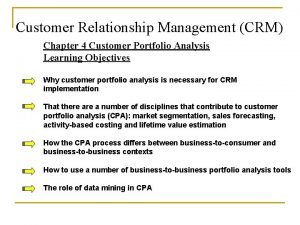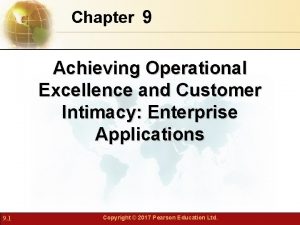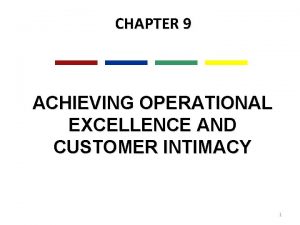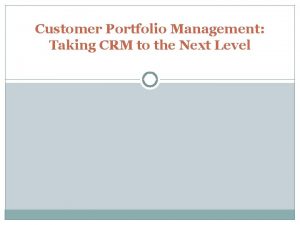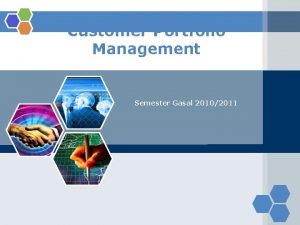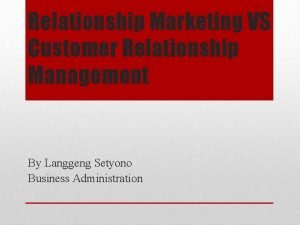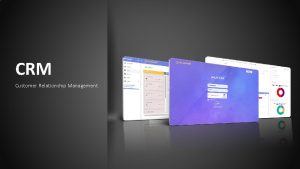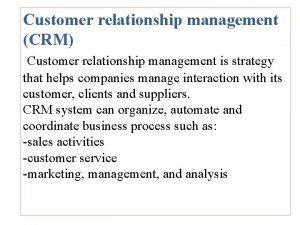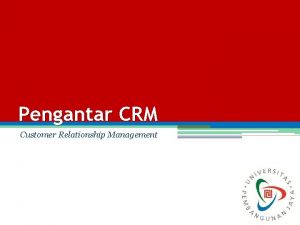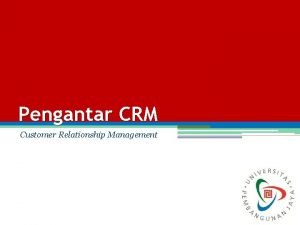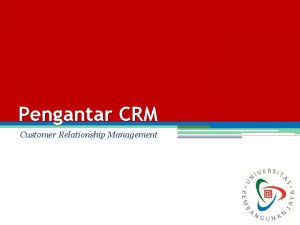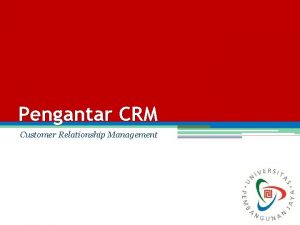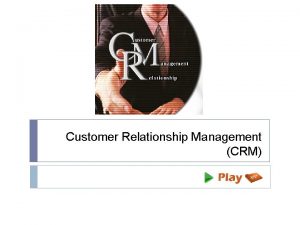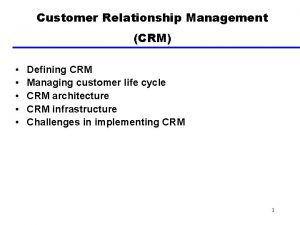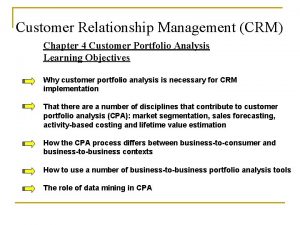Customer Relationship Management CRM Chapter 4 Customer Portfolio











- Slides: 11

Customer Relationship Management (CRM) Chapter 4 Customer Portfolio Analysis Learning Objectives Why customer portfolio analysis is necessary for CRM implementation That there a number of disciplines that contribute to customer portfolio analysis (CPA): market segmentation, sales forecasting, activity-based costing and lifetime value estimation How the CPA process differs between business-to-consumer and business-to-business contexts How to use a number of business-to-business portfolio analysis tools The role of data mining in CPA

Customer Portfolio toolkit In addition to specifically designed CPA tools, several other tools are in common use for planning corporate strategy. These are very useful for CRM applications. These tools, however, operate at a company-specific level. This means that a CRM strategist would apply the tools to a specific company to help in the assessment of the customer’s future value. The tools include: SWOT analysis PESTE analysis Five-forces analysis BCG matrix analysis.

SWOT: SWOT analysis explores the internal environment (S and W) and the external environment (O and T). The internal (SW) audit looks for strengths and weaknesses in the business functions of sales, marketing, operations, finance and people management. It then looks cross-functionally for strengths and weaknesses in, for example, cross-functional processes (such as new product development) and organizational culture. The external (OT) audit analyses the macro- and microenvironments in which the company operates. The macro-environment includes a number of broad conditions that might impact upon a company.

PEST: These conditions are identified by a PESTE analysis. PESTE is an acronym for political, economic, social, technological and environmental conditions. Political environment: demand for international air travel contracted as worldwide political stability was reduced after September 11, 2001. Economic environment: demand for mortgages falls when the economy enters recession. Social environment: as a population ages, demand for health care and residential homes increases. Technological environment: as more households become owners of computers, demand for Internet banking increases. Environmental conditions: as customers become more concerned about environmental quality, demand for more energy-efficient products increases.

CRM oriented Swot: The micro-environmental part of the external (OT) audit examines relationships between a company and its immediate external stakeholders: Customers Suppliers Business partners and investors. • Possess relevant strengths to exploit the opportunities • Are overcoming weaknesses by partnering with other organizations to take advantage of opportunities • Are investing in turning around the company to exploit the Opportunities • Are responding to external threats in their current markets by exploiting their strengths for diversification.

Five Forces: The five-forces analysis was developed by Porter. He claimed that the profitability of an industry, as measured by its return on capital employed relative to its cost of capital, was determined by five sources of competitive pressure. These five sources include three horizontal and two vertical conditions. The horizontal conditions are: • Competition within the established businesses in the market • Competition from potential new entrants • Competition from potential substitutes The vertical conditions reflect supply and demand chain considerations: • The bargaining power of buyers • The bargaining power of suppliers

Five Force: Porter’s basic premise is that competitors in an industry will be more profitable if these five conditions are benign. If buyers are very powerful: they can demand high levels of service and low prices, thus negatively influencing the profitability of the supplier. If barriers to entry are high: Say because of large capital requirements or dominance of the market by very powerful brands, then current players will be relatively immune from new entrants and enjoy the possibility of better profits. Why would a CRM strategist be interested in a five-forces evaluation of customers? Fundamentally, a financially healthy customer offers better potential for a supplier than a customer that is financially stressed. The analysis points to different CRM solutions.

Five Forces: • Customers in a profitable industry are more likely to be stable for the near term, and are better placed to invest in opportunities for the future. They therefore have stronger value potential. These are customers with whom a supplier would want to build an exclusive and well-protected relationship. • Customers in a stressed industry might be looking for reduced cost inputs from their suppliers, or for other ways that they can add value to their offer to their own customers. A CRM-oriented supplier would be trying to find ways to serve this customer more effectively, perhaps by stripping out elements of the value proposition that are not critical, or by adding elements that enable the customer to compete more strongly.

BCG Matrix: The Boston Consulting Group (BCG) matrix was designed to analyse a company’s product portfolio with a view to drawing strategy prescriptions. The analysis takes into account two criteria, relative market share and market growth rate, to identify where profits and cash flow are earned. The BCG believes that the best indicator of a market’s attractiveness is its growth rate (hence the vertical axis of the matrix) and that the best indicator of competitive strength is relative market share (the horizontal axis). Relative market share, that is the market share of the business unit relative to the largest competitor, is claimed to improve the relative cost position due to the experience curve.

BCG Matrix:

Thank you!!! Q&A
 Crm portfolio
Crm portfolio Customer relationship management and customer intimacy
Customer relationship management and customer intimacy Customer relationship management and customer intimacy
Customer relationship management and customer intimacy Customer relationship management and customer intimacy
Customer relationship management and customer intimacy What is customer portfolio management
What is customer portfolio management Functional component of ecrm
Functional component of ecrm Crm constituent relationship management
Crm constituent relationship management Operations plus
Operations plus Portofolio customer service
Portofolio customer service Customer portfolio management models
Customer portfolio management models Customer classification matrix
Customer classification matrix Customer relationship mangement
Customer relationship mangement
